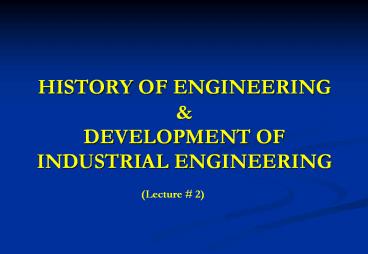HISTORY OF ENGINEERING - PowerPoint PPT Presentation
Title:
HISTORY OF ENGINEERING
Description:
Industrial engineering developed as a profession based on 'science' rather than 'art' ... Rapid and accurate handling of vast amount of data ... – PowerPoint PPT presentation
Number of Views:1296
Avg rating:3.0/5.0
Title: HISTORY OF ENGINEERING
1
HISTORY OF ENGINEERINGDEVELOPMENT OF
INDUSTRIAL ENGINEERING
(Lecture 2)
2
Chronology of Industrial Engineering
- Emergence of IE increasing need for technically
trained people who could plan, organize, and
direct the operations of large complex systems - History supervisors were given verbal
instructions - Any improved efficiency usually came from worker
himself - F. W. Taylor analyzing and the work content of
a job and designing the job for maximum
efficiency effects on planning, scheduling and
process
3
Chronology of Industrial Engineering
- F. B. Gilbreth analysis, measurement of
fundamental motions reach, grasp and
transport - H. L. Gantt Gantt chart systematic graphical
tool for preplanning and scheduling activities,
reviewing progress, and updating schedule - W. A. Shewhart fundamental principles of
quality control in 1924 - Industrial engineering developed as a profession
based on science rather than art
4
Chronology of Industrial Engineering
- The history of IE is spread on the overlapping
periods of - Scientific Management 1900 1930
- Industrial Engineering 1920 Present
- Operations Research 1940 1970
- IE Systems Engineering 1970 Future
- We can see that IE has seen most of its
developments in the last century - The new orientation i.e. IE Systems Engineering
is building not only on the foundation of IE/OR
but is also taking the concepts from feedback
control, computer science and systems engineering
etc.
5
(No Transcript)
6
Industrial Engineering Organizations
- The society of industrial engineers was formed
prior to 1920. - AIIE which later became IIE was formed in 1948
a technical society for industrial engineers
which has many university chapters - The Journal of IE (1949) was divided into
Industrial Engineering (monthly) and IIE
Transactions (quarterly) - Practicing industrial engineers belong to other
organizations also. - IIE membership view their professional activities
as concerned with broad aspects of total system
design
7
Industrial Engineering Education
- Industrial engineering is concerned with the
design, improvement, and installation of
integrated systems of people, materials,
information, equipment, and energy. It draws upon
specialized knowledge and skill in the
mathematical, physical, and social sciences - The basic principles of IE are being applied
widely in agriculture, hospitals, banks,
government organizations, and so forth - IE was predominantly taught in mechanical
engineering departments until the end of World
War II - PhDs in industrial engineering go into teaching
and positions in industry and government
8
Impact of Related Developments
- Impact of Operations Research
- Impact of mathematical analysis approach called
operations research (e.g. strength, mix and cost
of an alloy) - Operations research connects a set of
quantitative methods that are applicable to a
wide range of managerial and operational problems - Impact of Digital Computers
- Rapid and accurate handling of vast amount of
data - Managing and controlling large, complex
operations - Techniques like simulation and CAD/CAM (e.g.
cutting path) - Automatic generation of process plans, bills of
material, work schedules etc - Computer networks make all computers talk to each
other CIM - Emergence of Service Industries
- Hospitals, clinics eliminate wastes, schedule
activities - Government organizations increase efficiency,
reduce paperwork, project management
9
Relationship of to Other Engineering Disciplines
10
Challenges of the Future
- Learn to accomplish their mission in recognition
of the constraints oil, other natural resources
etc - Design systems compatible with the natural
environment wastes - Design products that are safe and reliable
quality control - Improve productivity US markets in comparison
to other countries - In short, engineers will be expected to design
systems that optimally utilize resources for the
satisfaction of human needs (definition)

